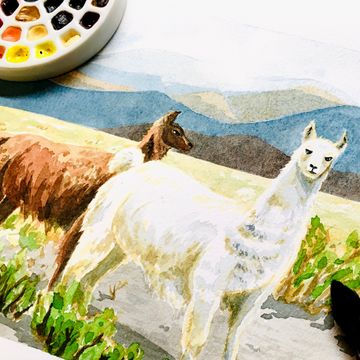
Have you ever gone out to do some Plein air painting, only to realise that you’ve forgotten to bring a pencil? Or maybe you’re doing a timed painting, and need to save time somewhere?
Well, it may seem a bit daunting at first, but it is possible to sketch in watercolour!
And unless you’re used to painting without doing a pencil sketch first, it will take a bit of practice to get the hang of doing a watercolour sketch.
There are a few benefits of this, which we’ll explore below.
Timesaver

One of the biggest advantages of sketching in watercolour instead of pencil would be how much time it saves.
I think we’ve all been in the position where we start our initial sketch, only to keep drawing and fixing it until it’s absolutely perfect before beginning the painting.
There’s nothing wrong with that, but sometimes, it’s good to add a time constraint, as it really gets you to practice efficiency while drawing or painting.
It also has the added benefit of trying a looser painting style, though it’s still possible to fix your painting as you go.
And lastly, this is a great way to quickly paint things that move, such as animals or people.
You’re capturing this moment in time, and doing that pencil sketch will take too long!
Seamless Painting

Each artist is different, but if you’re the type who hates seeing pencil marks or the underlying sketch in a watercolour painting, then a starting sketch in watercolour is for you.
Just make sure to use the matching and light colours of the objects in your painting for your sketch!
You can easily cover them later with your next layers of paint.
It’s also possible to lift out these lighter paint lines by using a wet brush and gently going over the paint you want to remove, then dabbing the area with a paper towel or clean rag.
For instance, I sketched the horizon line through the llama’s heads, so I had to lift these lines out for the white llamas since I knew I couldn’t cover all these lines later with more paint.
Bold Strokes

There’s actually another type of watercolour sketch, which is technically still a sketch in its roughness, but bolder in application.
For this, it’s better to make each brushstroke count! And make sure to vary the thickness of each stroke, depending on how “heavy” the line should feel.
This is similar to Chinese or Sumi-e painting, where you’re focused on capturing the essence of the scene rather than painting every little detail.
And while there’s a little wiggle room for you to play around (especially in terms of colour), as a sketch, it’s okay to leave in mistakes; and to really study exactly what it is that makes your subject look the way it is.
In the picture above, I painted the one on the left in 1 hour, and the one on the right in 20 minutes.
It helps to be more daring by giving yourself a time limit, and to use one big brush to paint everything!
Bonus tip: This method is great for painting anything that has way too many details, as you learn to simplify and strip away all the excess trimmings and let yourself boil down the painting to its barest of bones.
A Rough Sketch

In the end, there’s much value to trying out a few watercolour sketches, and you’re bound to learn a lot along the way.
The important thing here is the process since the final painting is not meant to be perfect.
As long as you remember to treat it as a sketch and a good lesson to learn, you’ll be well on your way to improving and refining your own painting process! And as always, happy painting (and sketching).
Do you sketch in watercolour? Which method have you tried, or have incorporated into your painting process? Let us know in the comments below!


